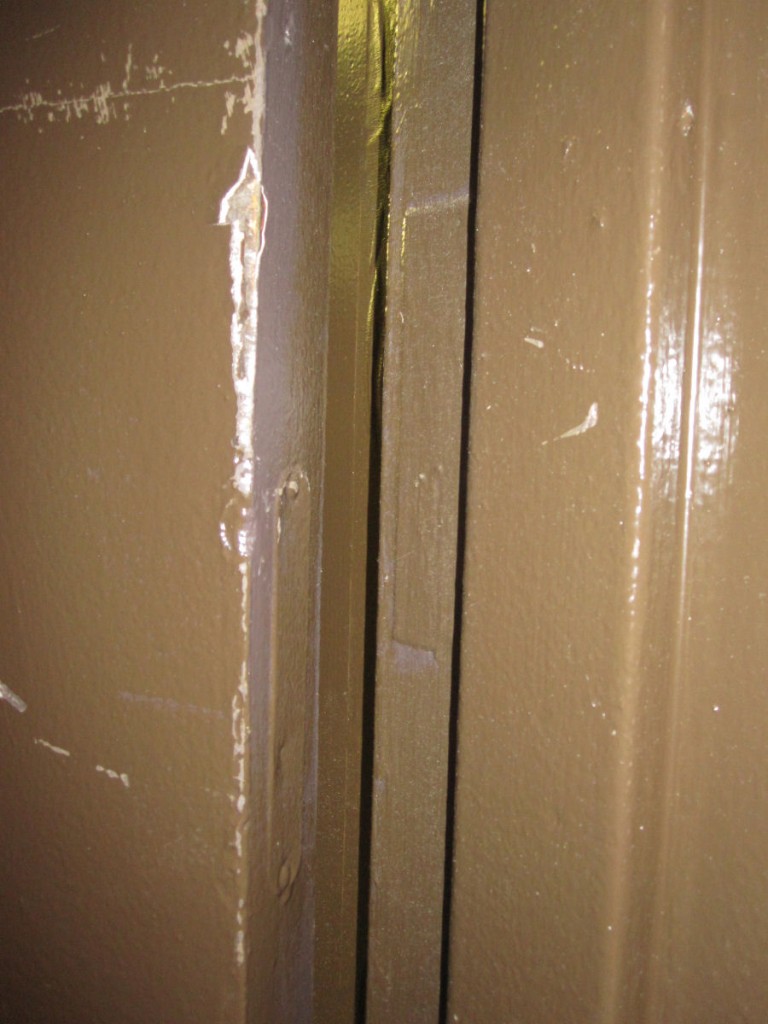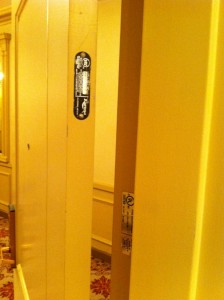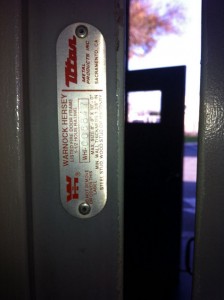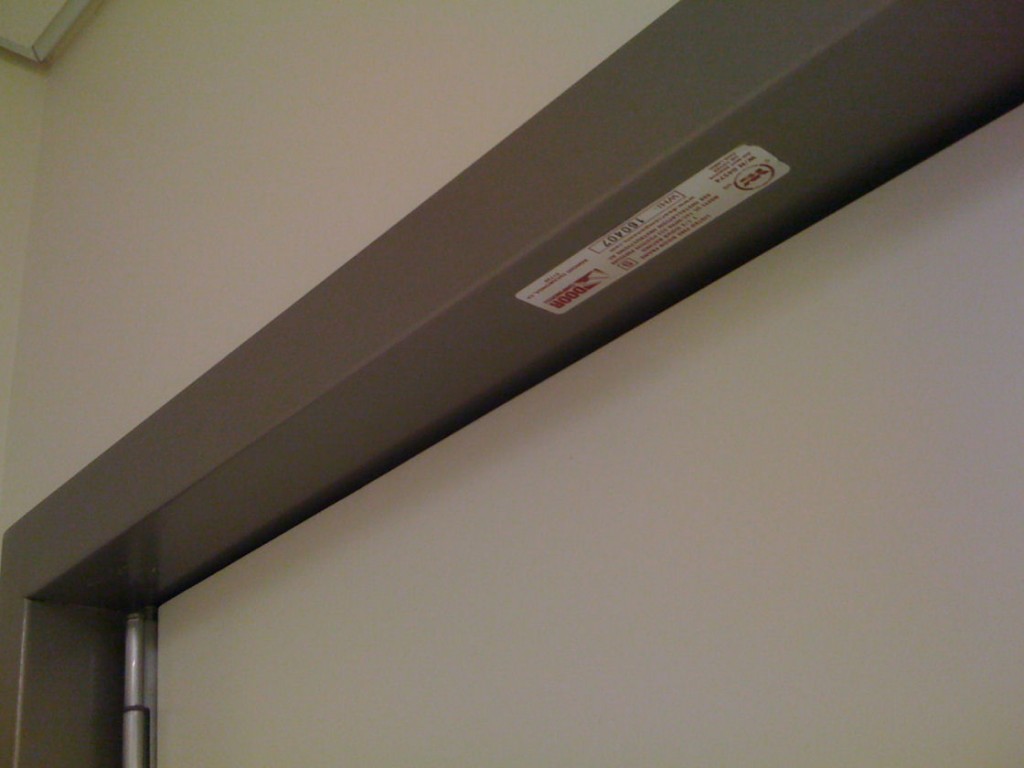 Questions about frame labels have come up several times this week, so I guess it’s time for a post. I’ve pulled together some information from various sources and I hope some of you will chime in with your input.
Questions about frame labels have come up several times this week, so I guess it’s time for a post. I’ve pulled together some information from various sources and I hope some of you will chime in with your input.
The most common questions on this topic are:
- Can a label on a fire-rated frame be painted?
- The label on my frame has no hourly designation…how do I know what the rating of this frame is?
- What types of labels are allowed to be used on fire-rated frames?
- What if the label is missing and I can’t see any indication of a rating?
Underwriters’ Laboratories has published a short, but informative article about label considerations on fire door frames. On the topic of painting labels, the articles states that “The embossment of the information on the label must be bold enough that it will be easily visible once painted. UL permits and encourages painting of embossed labels so they will not corrode and become illegible once the frames are installed. As such, it has been felt that the painting of an embossed label will not affect the rating of the frame or the legitimacy of the UL label…Labels that do not feature raised embossment of the label information should not be painted, as the paint will obscure the information.” So there you go. According to UL, you can paint over an embossed label as long as the information on the label is still legible. Not all code officials will agree with that…fair warning.
There’s A LOT of information about the hourly designations of fire-rated frames in the UL Certifications Directory, but the most concise answer to whether the hourly designation has to be on the label is in SDI-118. This is a publication of the Steel Door Institute called “Basic Fire Door Requirements,” and it includes a paragraph that sums it up clearly: “Fire doors frames are not affected by the exposure ratings and opening classifications that apply to doors. There are no hourly ratings for a basic fire door frame unless the labeling on the frame specifically states that the frame is rated for something less than 3 hours. If a frame bears a recognized label qualifying it as a fire door frame, it may support a 3-hour, a 1-1/2-hour, a 3/4-hour, or a 1/3-hour door. Frames used in masonry walls may be used with a maximum 3-hour fire door, while frames used in drywall walls are intended to be used with a maximum 1-1/2-hour fire door.” So if there’s no hourly designation on the label, the frame would typically be acceptable for up to 3 hours depending on the wall type, but the rating of the assembly is equal to the lowest-rated component. So if the frame is good for up to 3 hours and it’s a 90-minute door, it’s a 90-minute assembly (if the hardware, glass, etc., are correct). Sidelite, transom, and borrowed lite frames in rated walls will have an hourly designation on the label because they would not qualify for a 3-hour rating.
Here’s what NFPA 80-2007 says about labeling frames for fire doors:
“6.3.1.1* Only labeled door frames shall be used.
A.6.3.1.1 Door frames might carry a label stating the hourly rating. The rating of the installed assembly should carry the rating of the door or the door frame, whichever is less.”
And here’s what NFPA 80-2007 says about labels in general:
“4.2.1* Listed items shall be identified by a label.
A.4.2.1 Labels can be permitted to be of metal, paper, or plastics or can be permitted to be stamped or diecast into the item. Labels should not be removed, defaced, or made illegible while the door is in service. If the label on an existing fire door has been removed or is no longer legible, it is acceptable to verify the rating of the fire door through other means acceptable to the authority having jurisdiction such as an inspection or certification service that provides acceptable documentation.
4.2.2 Labels shall be applied in locations that are readily visible and convenient for identification by the AHJ after installation of the assembly.”
A little vague, but hopefully enough to help us understand the intent, right? And finally, if the frame is supposed to be rated and the label is illegible or there’s no visible label at all, what do you do? I talked to one hospital facility manager (who coincidentally happened to work in the hospital where I was born!), who told me that they have a procedure for removing paint from labels. They apply Sherwin Williams Smart Strip on the label with an artist’s brush, cover it with tape, and come back a couple of hours later to peel it off. I haven’t tried it so I can’t vouch for this procedure, but that’s what works for them. If there’s no label at all, the frame can be evaluated and possibly re-labeled in the field. Intertek offers this service, and UL also offers field evaluations. (Here’s a UL article on this topic).
Here are some label photos, courtesy of Hal Kelton of DoorData Solutions, and Mark Lineberger of Valley Doors & Hardware. Thanks guys!
You need to login or register to bookmark/favorite this content.










Thanks for the detailed information on door frame labels, Lori. It is very helpful.
Lori –
On your DHI Q&A transcription, you had mentioned that Intertek had a new program that certifies people to “field modify fire rated wood doors and apply a label in the field”. Now you mentioned this “Perfect Raceway Program” in talking about field drilling a raceway for electrified hardware on a wood fire door, however, I was wondering if, because of the “apply a label in the field” does this mean one can be certified to evaluate and inspect a fire door that bears no label and then apply it in the field or does this only apply to an already labeled wood fire door that has been field modified?
Lori very good article. Keep up the good work and spread the message!
Requesting informtion on services to verify and label existing doors, doors jambs, and rated hardware.
Hi Robert –
If you have existing doors and frames that need to be relabeled, I only know of a few agencies that perform that service. Intertek and UL both offer field labeling, or there may be a local company near you that can do it.
Here is a link for Intertek: http://www.intertek.com/building/fire-doors/field-labeling/
And one for UL: https://ifs.ul.com/fieldinspections/ulfi.nsf
If this is not what you were looking for, let me know.
– Lori
Factory Mutual has done several fire door inspections for us and provided documentation for equivalent fire door ratings for doors that were not fire rated but needed to be upgraded to fire doors due to design changes upgrading the associated wall.
Hi Lori,
I really appreciate this site, it’s been very helpful in seeing many different situations that one might come across in the field.
I was looking over some past posts and saw this one which caught my eye. I just wanted to make the point that QAI Laboratories is also an approved agency that can field label frames and doors if the labels have gone missing or if the opening has been modified in any way.
More information can be found at the website: http://qai.org/inspection-fire-door-field-labeling.html
Thanks again.
Anybody know where one would go to become certified in relabeling doors / frames ?
Thanks Lori for substantial information. Lucky for me when i decided to change our doors with frames for fire doors. I have nothing to worry with regards to painting it and installing. It came so handy i am very thankful to http://www.firesystems.com.au/ their customer service and product is really a top quality.
Lori
Nice article, on another note with respect to Smoke Doors and frames. Is a Smoke door required to be labeled with rating i.e. 20 Minutes etc…
Hi Joe –
It really depends on where the door is located. There are lots of different doors that people call “smoke doors”…some have a fire rating and some don’t.
– Lori
Hi Lori
Have you seen the fire rated door had these condition?
1) a fire rated door with UL labeled frame and WHI labeled door panel by two different manufacturers
2) a fire rated door with UL/WHI labeled frame and door panel but by two different manufacturers
Is it acceptable under IBC? Or I just pass the UL/WHI field inspection service. Then the fire rated door can be used and fulfill IBC?
Thanks for your attention
Peter Chan
Hi Peter –
NFPA 80 permits doors and frames from different manufacturers and different listing laboratories, so what you’re describing doesn’t sound like a problem.
– Lori
Hi Lori
Thank you your reply. It is clear
Attended a recent seminar, instructors were in a debate regarding removing label from door if not serving a code requirement for installation, such as a sprinkled smoke partition. One in instructor said”, no to removal of label, but yes to removal of door?? Can labels be removed, if not needed for code, such as resident rooms.
Hi Bob –
It is ok to remove labels…just make sure you REALLY don’t need a labeled door because once you remove a label you’re not supposed to put it back on.
– Lori
In what year did door frames require rating and a label?
Hi Gerry –
I’m not sure exactly when that was added to the codes and standards.
– Lori
If the New Fire Rated door that we’ve ordered arrived on site without the Fire Rating label, could the manufacturer provide the label and who can install this labels provided by the manufacturer.
Hi Ireneo –
As far as I know, the manufacturer can not send you the label separately. It needs to be applied in the field by someone who is certified to re-label doors, or taken to an authorized facility to be labeled. I would recommend checking with the manufacturer to make sure their policies have not changed.
– Lori
Lori, Please clear this up for me. For years, on a pair of doors, I have always attached a label to EACH hinge jamb. Lately, I have seen frames with the label affixed to one jamb only. is that acceptable?
This is a great question! I had to check with one of our engineers. Only one label is required for a pair frame, although it’s ok to attach two. Here’s the info from the UL directory (other labeling agencies have similar language): The UL Listing Mark shall be applied to the door rabbet of each hinge jamb approximately two-thirds up from the base. See Ill. 3 of this section. Set-up arc-welded frames or frames which are unit bundled (head & jambs bundled together), for pairs of doors require only one UL Listing Mark. Set-up arc-welded communicating type frames require only one UL Listing Mark.
– Lori
I have a job where the Manf did not label the frames, but all the doors are labeled accordingly (Metal Doors & Metal Frames). I have a letter from the manufacturer that certifies all their frames are built to meet all the necessary fire ratings (basically all that is lacking is the physical label). I assume local jurisdiction will have the final say, but i am curious if there is a code that allows the door label to carry the entire opening.
Your article references code “A.6.3.1.1 Door frames might carry a label stating the hourly rating. The rating of the installed assembly should carry the rating of the door or the door frame, whichever is less.”. Using this, it appears my rating on the opening would be Non Rated, as the lesser of the two is the frame, which is not labeled.
As always, i appreciate your site.
Hi Mike –
This will be up to the AHJ…the frames may need to be field labeled – or not.
– Lori
My company needs to replace a fire door with a new door. The current frame and door are labeled. When the new fire door is installed can in be installed in the existing frame since both are listed with the same rating but from different manufacturers?
Hi John –
Yes, NFPA 80 allows products from different manufacturers and even different listing labs to be used in the same fire door assembly:
4.2.6 Components.
4.2.6.1 A fire door assembly shall consist of components that are separate products incorporated into the assembly and are allowed to have their own subcomponents.
4.2.6.2* Except where restricted by individual published listings, a fire door assembly shall be permitted to consist of the labeled, listed, or classified components of different organizations that are acceptable to the AHJ.
– Lori
Lori,
You are doing great work.
I have a question:
In training, and many other places online I see the phrase “the rating of the assembly is equal to the lowest-rated component.” but I struggle to find that in the code. I have looked in 80, 101, and local codes. Do you know where I can find that information?
Thank you,
Thanks Rick!
I have never seen it written in a code or standard…it’s just one of those things that we all learned years ago. I will ask for an NFPA staff opinion so we have something in writing.
– Lori
Thank you for looking into it. I fully expect to hear the magic hardware words: “It depends.”
Is the 45minute transom/frame 20 minute door in hallway applications the only exception that you know of?
What kicked off my deeper research was when a customer specifically ask for a 1 hour door in a 20 minute frame.
It’s unusual for someone to ask for that type of mis-match…usually it just happens because some components are rated for a longer time period than others. As long as all of the components are greater than or equal to what is required, the assembly should be acceptable.
– Lori